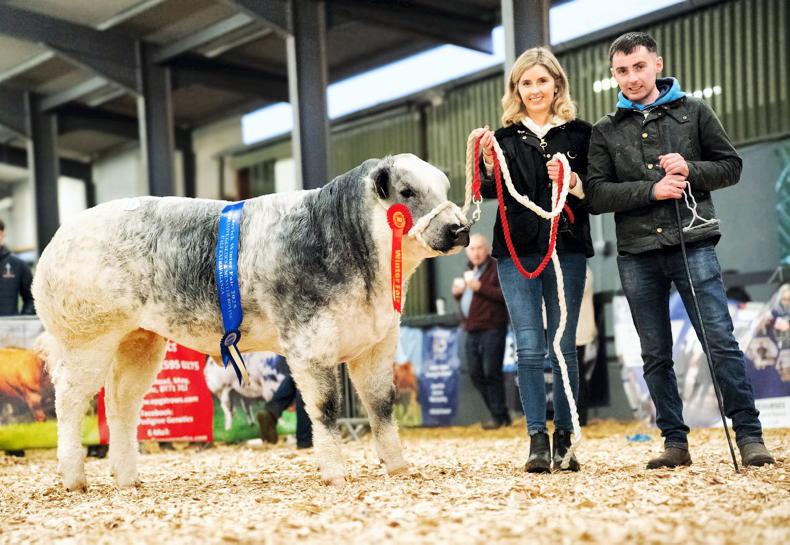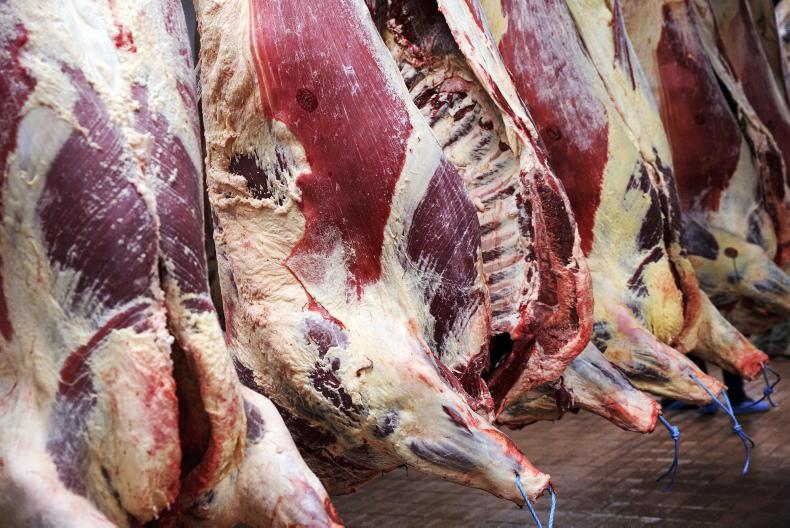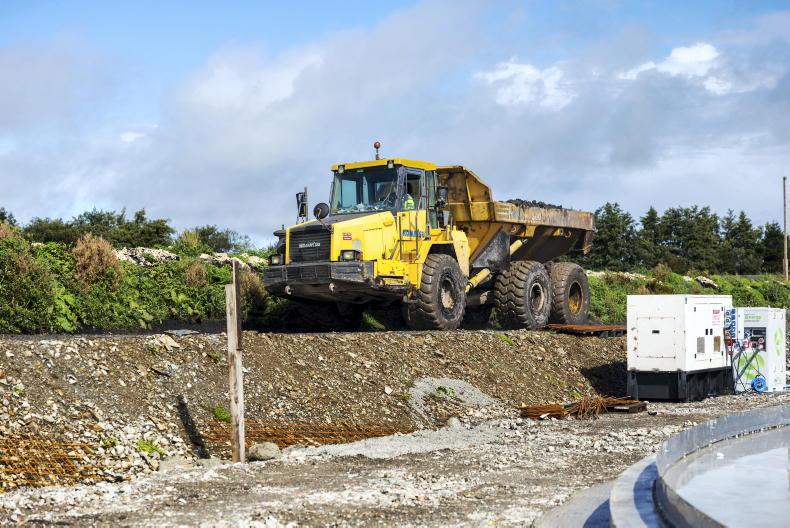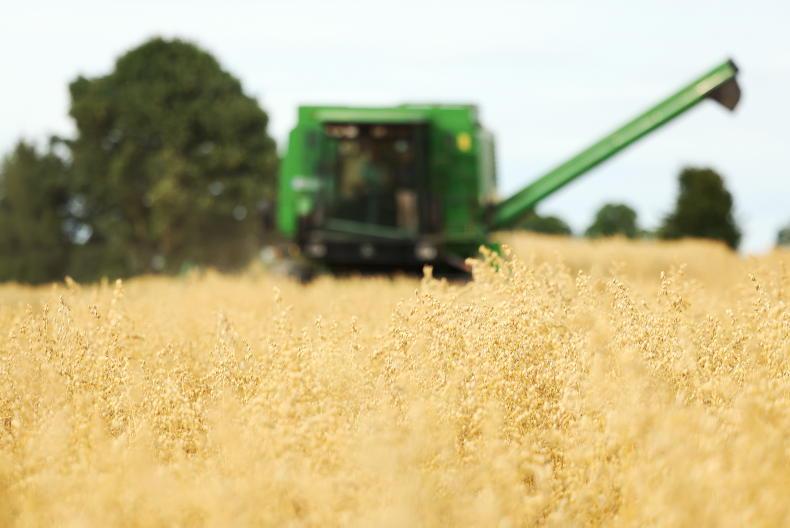An influx of drystock farmers have entered into organics in the last two years, with the 2025 target of 5% of agricultural land being farmed organically already having been met, with a target of 10% by 2030.
A lot of this can be attributed to the significant purse of money that the Department of Agriculture has thrown at organics, with €50m to €55m dedicated to organics in 2024.
Looking at it from an on-farm basis, it’s worth between €11,000 and €12,000 for the average drystock holding.
A major issue currently with organic systems is ‘leakage’ of organic beef and lamb into conventional systems.
Currently, 70% of organic lamb and 30% of organic beef is being ‘leaked’, mainly through organic store lambs and store beef cattle being sold on for finishing into conventional farms.
Traditional weanling and store lamb producers will therefore not see the additional carcase premium on their produce, with both the availability and the cost of organic feeds being part of the reasons these new organic farmers do not have the appetite to see their produce through to finishing.
The herd is majority Simmental and Limousin-cross cows such as the one pictured above.
Ken Gill has been farming organically for 10 years, and through rotation and autumn calving, he is now successfully finishing all beef stock through to finishing at 24 to 25 months of age with little to no concentrates.
Ken’s system
Ken runs between 60 and 65 autumn-calving cows in his Offaly holding.
The primary cow type on the farm are Limousin and Simmental-cross cows mated back to AI Angus or Hereford sires for ease of finishing, with a proportion of cows bred back to Limousin and Simmental for heifer replacements.

Calves have access to their own bedded creep area as well as paddocks outdoors.
Originally, the farm was operating a split-calving pattern, with spring and autumn calving happening mainly to ensure a steady stream of finished cattle throughout the year as part of an organic group.
The farm has now moved away from this, with Ken focusing on a compact calving period in September and October.

Ken Gill has been operating an organic beef system for 10 years and is proof that output of beef can compare to a conventional system.
While Ken admits that all data from Teagasc rightly points to spring calving being more profitable in conventional beef systems by grass utilisation; by switching to autumn calving all beef cattle can be successfully finished on-farm at 24 months by the end of their second summer, limiting the concentrate inputs into finishing these cattle.
If Ken was in a spring-calving system, the second winter where cattle would result in costly concentrates going into stock to obtain sufficient fat cover.
AI and herd fertility
The 2023 autumn-calving season began on 8 August and finished on 15 December, lasting 18 weeks in total. All cows were calved within six and a half weeks. Seventy-four females calved in total, consisting of 24 heifers and 50 cows.
The herd’s calving interval was 374 days, close to the target of 365 days and well below the national average of 390 days.

With 100% AI being used, calf quality is high on the Gill farm.
The extended calving period was a result of a rogue bull weanling impregnating additional heifers.
All calves are now disbudded and banded at a week old to prevent this happening in the future.
A major focus goes into breeding on the farm. Breeding started on 30 October with a strict six weeks of AI carried out.
Heifers were bred to AA6682 and AA4303, while the cows were bred to AA4087, AA4303, AA4089, AU4683, LM4302 and LM4351.
After narrowing down the breeding list by selecting cows for culling, Ken bred 35 to replacement bulls, 31 cows to terminal bulls and the 17 heifers were bred to easy-calving bulls with good maternal and terminal traits.
For those six weeks, cows were checked from 7am in the morning until 11pm at night at regular intervals. Ken is striving for a compact calving and breeding period to allow him to be able to take time away from the farm when breeding and calving is not taking place, as well as aiming to have a more consistent batch of cattle for management and feeding.
Youngstock management
Autumn-born calves have access to a separate creep area away from their mothers where they are offered high DMD silage and access to a paddock for grazing.
The dams themselves received 77% DMD silage up until breeding and are now on second cut, which is still of good quality.
No meals are fed to cows indoors, something that would be typical of conventional autumn-calving herds.
For the summer months, Ken operates a leader-follower system
While the majority of oats go on to Flahavan’s, a small amount is kept and fed to calves pre-weaning, with nose paddles also used to minimise stress at weaning time.
For the summer months, Ken operates a leader-follower system, with calves grazing a fresh paddock for one day before moving on. They are then followed by the yearlings who will graze the paddock for a day before the autumn-calving cows come into clean up the remainder.
There are several benefits to the above weanlings and yearlings receiving the best grass while the worm burden on young cattle is reduced. Cattle on Ken’s farm typical receive only two worm drenches in their life.
Autumn-calving cows are kept fit and not fat, while paddocks are cleaned out with minimal topping now happening on the farm. The average pre-grazing yield on the farm last year was just over 1,400 kg DM/ha, bang on target, while the grassland stocking rate is 1.52 LU/ha, not far behind that of conventional suckler to store systems sitting at an average of 1.59 LU/ha.

Yearling cattle have been wintered indoors since mid-December on red clover silage.
Yearling cattle are then wintered on turnips, rape and kale up until December, before moving indoors on red clover silage and no meal.
With no finishing cattle on the farm over the winter, this high-quality fodder can be targeted at the growing cattle and ensure target weights for turnout in spring are met. Both yearlings and cows feed on slatted areas with straw liebacks to satisfy the organic housing requirements.
Slaughter performance
The 2022-born bullocks and heifers were weighed on 22 December after coming in off the turnips, rape and kale and gained 0.49kg/day and 0.53 kg/day off the crop, which is low compared to past years.
However, the average daily liveweight gain of the 2021-born cattle is on par with other years, despite the difficult grazing conditions of 2023.
Bullocks had an average daily gain of 0.84kg/day from birth to slaughter, with heifers coming in at 0.78kg/day.
Ken uses no concentrates in the finishing period
Slaughter data from the 2021-born finished cattle is also impressive. Bullocks killed out at 361kg carcase weight, grading R=3- at 25 months, with heifer carcases at 328kg and grading R+3- at 25 months.
The additional month past the 24-month target was owing to the tough grazing conditions of 2023, but still holds its own against a national average of a 395kg carcase at 28 months for bullocks and a 333kg carcase at 25 months for heifers.
Ken uses no concentrates in the finishing period, all the while collecting the carcase premium for his organic cattle and additional organic payments.
Most of the fields are in 12ac blocks, which Ken subdivides for grazing. Regarding the crops, 12 to 24 acres of oats are sown annually, with 12 to 24 acres of red clover grown.
Peas, oats and barley are sown with the red clover as a nurse crop and to bulk up the first cut, with oats being sown with a half rate of grass seed and some clover included to allow for grazing of stubbles.
This year, the stubble ground was used as a grass lieback for the turnips, rape and kale.
Due to no herbicide usage, everything is ploughed to keep weeds at bay.
Grass is ploughed in July and sown with turnips, rape and kale to break up the sod and improve soil structure. That ground is then sown with oats the following spring for two years with the grass and clover included.
Three silage cuts
Red clover is then sown in a four-year ley, with three cuts of silage taken off it annually before being mulched in October for green manure.
The red clover is never grazed as Ken classes it as too risky. Slurry is spread in between cuts with farmyard manure applied in the autumn.
The red clover goes back into turnips, rape and kale after the red clover before going back into oats again to utilise the nutrient buildup held in the soil.
The ground is eventually sown back into grass then.
System a credit to farmer
By Ken’s own admission, he is lucky with the land that he has in that it is all in one block and of good quality, which not every suckler farmer can say.

Yearling bullocks have had an average daily gain of 0.84kg/day from birth, with heifer at 0.79kg/day.
However, Ken’s tweaking of the system, which allows him to finish cattle off grass by autumn calving, without feeding meal to cows and still recording an exceptional herd fertility, is a credit to him.
While not every organic farmer can outwinter stock on stubbles or catch crops, nearly all should be fit to grow red clover silage and make high-quality grass silage, similar to what Ken is doing.
An influx of drystock farmers have entered into organics in the last two years, with the 2025 target of 5% of agricultural land being farmed organically already having been met, with a target of 10% by 2030.
A lot of this can be attributed to the significant purse of money that the Department of Agriculture has thrown at organics, with €50m to €55m dedicated to organics in 2024.
Looking at it from an on-farm basis, it’s worth between €11,000 and €12,000 for the average drystock holding.
A major issue currently with organic systems is ‘leakage’ of organic beef and lamb into conventional systems.
Currently, 70% of organic lamb and 30% of organic beef is being ‘leaked’, mainly through organic store lambs and store beef cattle being sold on for finishing into conventional farms.
Traditional weanling and store lamb producers will therefore not see the additional carcase premium on their produce, with both the availability and the cost of organic feeds being part of the reasons these new organic farmers do not have the appetite to see their produce through to finishing.
The herd is majority Simmental and Limousin-cross cows such as the one pictured above.
Ken Gill has been farming organically for 10 years, and through rotation and autumn calving, he is now successfully finishing all beef stock through to finishing at 24 to 25 months of age with little to no concentrates.
Ken’s system
Ken runs between 60 and 65 autumn-calving cows in his Offaly holding.
The primary cow type on the farm are Limousin and Simmental-cross cows mated back to AI Angus or Hereford sires for ease of finishing, with a proportion of cows bred back to Limousin and Simmental for heifer replacements.

Calves have access to their own bedded creep area as well as paddocks outdoors.
Originally, the farm was operating a split-calving pattern, with spring and autumn calving happening mainly to ensure a steady stream of finished cattle throughout the year as part of an organic group.
The farm has now moved away from this, with Ken focusing on a compact calving period in September and October.

Ken Gill has been operating an organic beef system for 10 years and is proof that output of beef can compare to a conventional system.
While Ken admits that all data from Teagasc rightly points to spring calving being more profitable in conventional beef systems by grass utilisation; by switching to autumn calving all beef cattle can be successfully finished on-farm at 24 months by the end of their second summer, limiting the concentrate inputs into finishing these cattle.
If Ken was in a spring-calving system, the second winter where cattle would result in costly concentrates going into stock to obtain sufficient fat cover.
AI and herd fertility
The 2023 autumn-calving season began on 8 August and finished on 15 December, lasting 18 weeks in total. All cows were calved within six and a half weeks. Seventy-four females calved in total, consisting of 24 heifers and 50 cows.
The herd’s calving interval was 374 days, close to the target of 365 days and well below the national average of 390 days.

With 100% AI being used, calf quality is high on the Gill farm.
The extended calving period was a result of a rogue bull weanling impregnating additional heifers.
All calves are now disbudded and banded at a week old to prevent this happening in the future.
A major focus goes into breeding on the farm. Breeding started on 30 October with a strict six weeks of AI carried out.
Heifers were bred to AA6682 and AA4303, while the cows were bred to AA4087, AA4303, AA4089, AU4683, LM4302 and LM4351.
After narrowing down the breeding list by selecting cows for culling, Ken bred 35 to replacement bulls, 31 cows to terminal bulls and the 17 heifers were bred to easy-calving bulls with good maternal and terminal traits.
For those six weeks, cows were checked from 7am in the morning until 11pm at night at regular intervals. Ken is striving for a compact calving and breeding period to allow him to be able to take time away from the farm when breeding and calving is not taking place, as well as aiming to have a more consistent batch of cattle for management and feeding.
Youngstock management
Autumn-born calves have access to a separate creep area away from their mothers where they are offered high DMD silage and access to a paddock for grazing.
The dams themselves received 77% DMD silage up until breeding and are now on second cut, which is still of good quality.
No meals are fed to cows indoors, something that would be typical of conventional autumn-calving herds.
For the summer months, Ken operates a leader-follower system
While the majority of oats go on to Flahavan’s, a small amount is kept and fed to calves pre-weaning, with nose paddles also used to minimise stress at weaning time.
For the summer months, Ken operates a leader-follower system, with calves grazing a fresh paddock for one day before moving on. They are then followed by the yearlings who will graze the paddock for a day before the autumn-calving cows come into clean up the remainder.
There are several benefits to the above weanlings and yearlings receiving the best grass while the worm burden on young cattle is reduced. Cattle on Ken’s farm typical receive only two worm drenches in their life.
Autumn-calving cows are kept fit and not fat, while paddocks are cleaned out with minimal topping now happening on the farm. The average pre-grazing yield on the farm last year was just over 1,400 kg DM/ha, bang on target, while the grassland stocking rate is 1.52 LU/ha, not far behind that of conventional suckler to store systems sitting at an average of 1.59 LU/ha.

Yearling cattle have been wintered indoors since mid-December on red clover silage.
Yearling cattle are then wintered on turnips, rape and kale up until December, before moving indoors on red clover silage and no meal.
With no finishing cattle on the farm over the winter, this high-quality fodder can be targeted at the growing cattle and ensure target weights for turnout in spring are met. Both yearlings and cows feed on slatted areas with straw liebacks to satisfy the organic housing requirements.
Slaughter performance
The 2022-born bullocks and heifers were weighed on 22 December after coming in off the turnips, rape and kale and gained 0.49kg/day and 0.53 kg/day off the crop, which is low compared to past years.
However, the average daily liveweight gain of the 2021-born cattle is on par with other years, despite the difficult grazing conditions of 2023.
Bullocks had an average daily gain of 0.84kg/day from birth to slaughter, with heifers coming in at 0.78kg/day.
Ken uses no concentrates in the finishing period
Slaughter data from the 2021-born finished cattle is also impressive. Bullocks killed out at 361kg carcase weight, grading R=3- at 25 months, with heifer carcases at 328kg and grading R+3- at 25 months.
The additional month past the 24-month target was owing to the tough grazing conditions of 2023, but still holds its own against a national average of a 395kg carcase at 28 months for bullocks and a 333kg carcase at 25 months for heifers.
Ken uses no concentrates in the finishing period, all the while collecting the carcase premium for his organic cattle and additional organic payments.
Most of the fields are in 12ac blocks, which Ken subdivides for grazing. Regarding the crops, 12 to 24 acres of oats are sown annually, with 12 to 24 acres of red clover grown.
Peas, oats and barley are sown with the red clover as a nurse crop and to bulk up the first cut, with oats being sown with a half rate of grass seed and some clover included to allow for grazing of stubbles.
This year, the stubble ground was used as a grass lieback for the turnips, rape and kale.
Due to no herbicide usage, everything is ploughed to keep weeds at bay.
Grass is ploughed in July and sown with turnips, rape and kale to break up the sod and improve soil structure. That ground is then sown with oats the following spring for two years with the grass and clover included.
Three silage cuts
Red clover is then sown in a four-year ley, with three cuts of silage taken off it annually before being mulched in October for green manure.
The red clover is never grazed as Ken classes it as too risky. Slurry is spread in between cuts with farmyard manure applied in the autumn.
The red clover goes back into turnips, rape and kale after the red clover before going back into oats again to utilise the nutrient buildup held in the soil.
The ground is eventually sown back into grass then.
System a credit to farmer
By Ken’s own admission, he is lucky with the land that he has in that it is all in one block and of good quality, which not every suckler farmer can say.

Yearling bullocks have had an average daily gain of 0.84kg/day from birth, with heifer at 0.79kg/day.
However, Ken’s tweaking of the system, which allows him to finish cattle off grass by autumn calving, without feeding meal to cows and still recording an exceptional herd fertility, is a credit to him.
While not every organic farmer can outwinter stock on stubbles or catch crops, nearly all should be fit to grow red clover silage and make high-quality grass silage, similar to what Ken is doing.
















SHARING OPTIONS